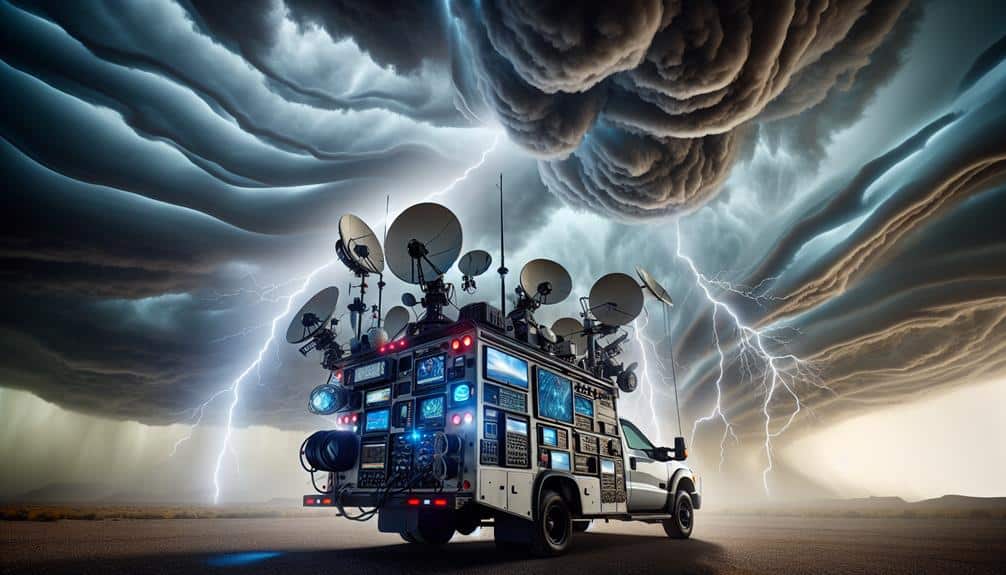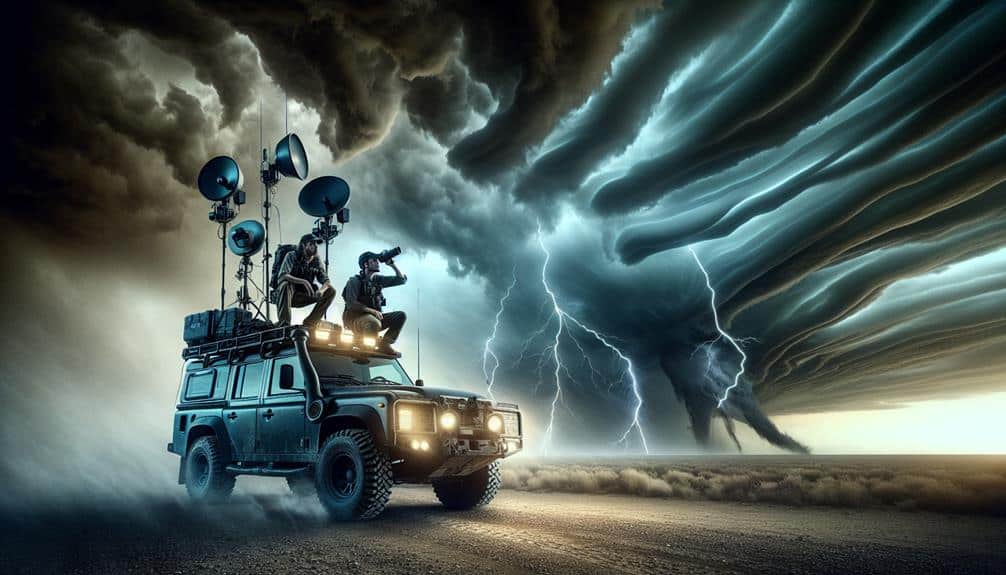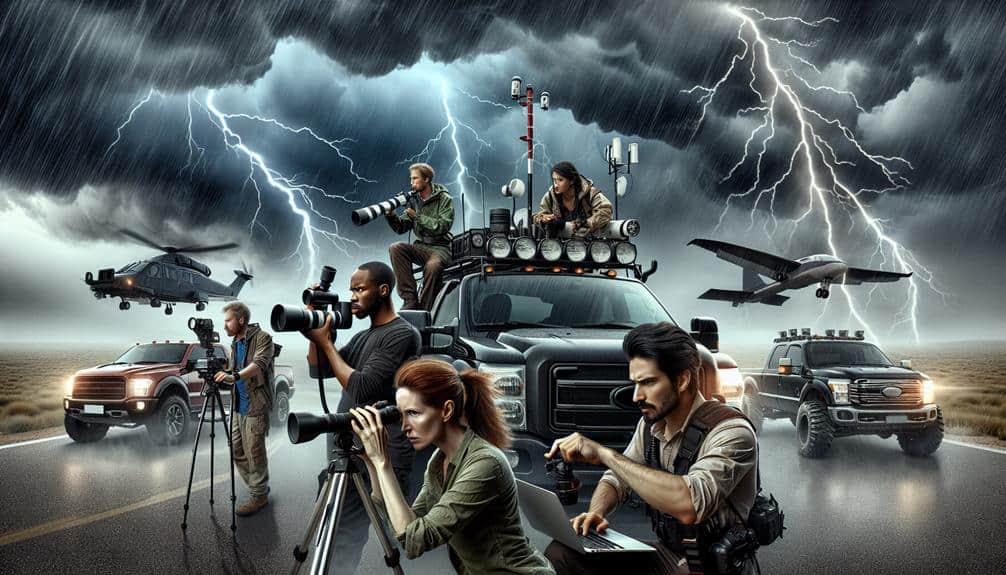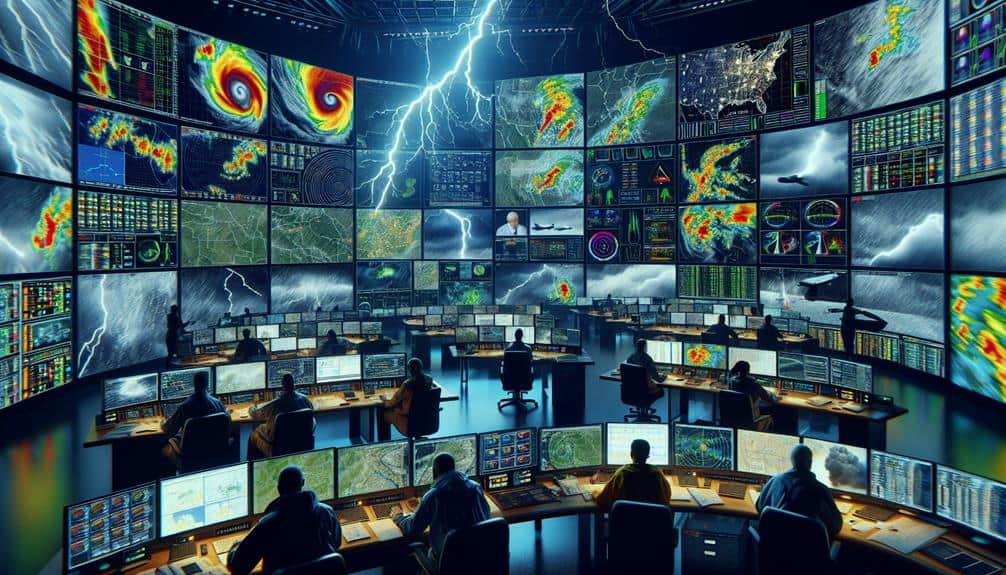In our storm chaser fleet vehicles, top gear includes advanced weather radar systems for real-time storm tracking, high-resolution cameras, and drones for capturing detailed weather dynamics. We rely on mobile communication gear, like satellite phones and radio scanners, to stay connected and informed. GPS navigation tools with integrated weather alerts ensure precise location tracking and route safety. We're prepared with emergency medical kits for immediate response to any injuries. Vehicle durability upgrades, such as underbody protection, shield our vehicles from rough terrain and debris. Data logging equipment captures key meteorological data, essential for understanding and predicting severe weather patterns. Discover what else keeps us at the forefront of storm chasing.
Key Points
- Real-time weather monitoring systems improve storm path and intensity predictions.
- High-resolution cameras and drones capture detailed storm footage.
- Satellite phones and advanced radio scanners ensure robust communication.
- GPS navigation tools with route optimization and weather alerts provide safe navigation.
Weather Radar Systems
For storm chasers, having an advanced weather radar system is essential because it provides real-time data on storm patterns and potential severe weather developments. With recent radar technology advancements, our ability to track storms with pinpoint accuracy has vastly improved. Gone are the days of relying on outdated systems; today's radar technology allows us to anticipate a storm's path and intensity with remarkable precision.
By incorporating cutting-edge radar systems into our fleet vehicles, we enhance not only our storm tracking accuracy but also our safety. Real-time data feeds enable us to make informed decisions quickly, avoiding hazardous situations and positioning ourselves where we can safely observe and document severe weather phenomena.
The impact of weather radar on storm chaser safety can't be understated. Accurate radar readings reduce the risks associated with unpredictable weather, ensuring we don't find ourselves in the direct path of danger.
In essence, these advancements in weather radar technology allow us to embrace our passion for storm chasing while minimizing risks. By leveraging the best tools available, we maintain the freedom to explore and document nature's most powerful forces without compromising our safety.
High-Resolution Cameras
Equipped with advanced radar systems to track storms accurately, we also rely on high-resolution cameras to capture every intricate detail of severe weather events. These cameras are important tools in our storm-chasing arsenal, allowing us to document and analyze the dynamics of storms with unmatched clarity.
Our high-resolution cameras deliver stunning visual data that not only aids in research but also enhances public awareness. Here's how they make a difference:
- Drone Surveillance: Using drones equipped with high-definition cameras, we can capture aerial footage of storm systems. This bird's-eye view provides a thorough understanding of storm structures and behavior.
- Time Lapse Photography: By setting up cameras to record time-lapse footage, we can illustrate the development and progression of storm systems. This technique reveals changes that occur over hours in just a few seconds of video.
- Night Vision Capability: Our cameras are equipped with night vision, enabling us to gather essential data even in low-light conditions. This guarantees we don't miss any important moments.
- Durability: Designed to withstand extreme weather conditions, our cameras function reliably under the harshest circumstances, ensuring continuous data collection.
Mobile Communication Gear
To maintain real-time coordination and secure safety, our storm chaser fleet vehicles are outfitted with cutting-edge mobile communication gear. This guarantees that we stay connected, no matter how remote or turbulent the conditions become.
We rely on satellite phones as a primary communication tool. These devices provide us with robust, reliable connectivity, even when traditional cell towers are down or out of reach. Satellite phones are indispensable, allowing us to relay critical information back to base and among team members. In the heart of a storm, where every second counts, the ability to communicate instantly can make the difference between a successful mission and a hazardous situation.
In addition to satellite phones, we equip our vehicles with advanced radio scanners. These scanners enable us to monitor emergency broadcasts, weather updates, and local communications, offering real-time data that's essential for making tactical decisions on the fly. By tapping into various frequencies, we gain a thorough understanding of the evolving storm landscape.
Together, satellite phones and radio scanners form the backbone of our communication strategy. They empower us to navigate unpredictable environments with confidence, ensuring that we remain informed, connected, and safe in our pursuit of the storm's fury.
While our communication gear keeps us connected, our GPS navigation tools guarantee we can pinpoint our exact location and plot the safest routes through perilous storm conditions. GPS technology is essential for storm chasers, offering precision and reliability in high-pressure scenarios.
For our fleet, we prioritize real-time tracking and route optimization. This secures we can adapt quickly and navigate efficiently. Here are four key components we rely on:
- Real-Time Tracking Systems: These allow us to monitor our fleet's precise positions, giving us a strategic advantage in rapidly changing environments.
- Route Optimization Software: By analyzing traffic patterns and road conditions, our software suggests the quickest, safest paths, even when storms are at their worst.
- Integrated Weather Alerts: Combining GPS with weather data, we receive instant notifications about severe weather, enabling us to avoid hazardous areas.
- Advanced Storm Tracking: Our GPS tools sync with storm tracking systems to provide up-to-the-minute information on storm movements, helping us stay ahead of perilous conditions.
These tools not only enhance our safety but also maximize our efficiency. By leveraging cutting-edge GPS navigation, we maintain our freedom to move swiftly and decisively when every second counts.
Emergency Medical Kits

Having a well-stocked emergency medical kit is necessary for storm chasers, ensuring we're prepared for any injuries or health issues that may arise in the field. Our unpredictable environment demands that we equip our vehicles with thorough medical supplies, ready for immediate use.
Each kit should include items essential for trauma care, such as bandages, antiseptics, gauze pads, and splints. These supplies are crucial for treating injuries ranging from minor cuts to severe wounds.
First aid training is a non-negotiable component for our teams. Knowing how to effectively use our medical supplies can make a significant difference in an emergency response situation. Basic skills like CPR, wound dressing, and splinting are indispensable. We also stock advanced tools like tourniquets and hemostatic agents for more serious injuries.
Ensuring our kits are up-to-date and replenished is a continuous process. Every team member should regularly check their kits and replace expired or used items. By prioritizing this, we maintain our readiness and safeguard our freedom to chase storms without compromising safety.
In the high-stakes world of storm chasing, preparation isn't just about the technology we carry but also about being ready to handle any medical emergency.
Vehicle Durability Upgrades
Improving the durability of our fleet vehicles is essential to guarantee they withstand the harsh conditions encountered during storm chases. These upgrades safeguard that our vehicles not only survive but thrive in the face of severe weather.
Here's what we need to focus on:
- Armor Plating and Reinforced Frames: Adding armor plating protects against flying debris, while reinforced frames bolster the vehicle's structural integrity. This combination guards against the unpredictable forces of nature, allowing us to push through intense environments safely.
- Heavy Duty Tires: Heavy duty tires are necessary for maintaining traction and stability on various terrains, from muddy fields to shattered asphalt. These tires are designed to endure the roughest conditions without compromising performance, keeping us on the move when it matters most.
- Suspension Upgrades: Storm chasing demands a ride that can handle the bumps and jolts of unpredictable terrain. Suspension upgrades provide better shock absorption, improving vehicle handling and comfort, which is crucial for long chases.
- Underbody Protection: Installing skid plates and underbody guards shields critical components from damage caused by rough ground and debris, ensuring the vehicle's operational longevity.
Data Logging Equipment

Equipping our storm chaser fleet with advanced data logging equipment allows us to capture significant meteorological data in real-time, enhancing our ability to analyze and predict severe weather patterns accurately. It's not just about gathering data; it's about obtaining precise, actionable information that can make all the difference in forecasting.
Our data logging systems include state-of-the-art temperature monitoring tools. These devices record the minutest changes in ambient temperature, providing us with necessary insights into storm formation and progression. Accurate temperature data helps us understand the thermal dynamics driving severe weather, enabling better predictive models.
Wind speed tracking is another essential component of our data logging arsenal. High-precision anemometers mounted on our vehicles measure wind speeds with remarkable accuracy, even in the most turbulent conditions. This data is crucial for evaluating storm intensity and potential damage zones, allowing us to anticipate and respond to rapidly changing weather scenarios.
Frequently Asked Questions
How Do You Train New Storm Chasers for Extreme Weather Conditions?
We juxtapose classroom learning with hands-on experience. Our training techniques cover meteorology basics, while safety protocols guarantee preparedness. We balance theory and practice, empowering new storm chasers to safely embrace the freedom of extreme weather adventures.
What Insurance Policies Are Recommended for Storm Chasing Vehicles?
We need extensive insurance coverage with high policy limits for storm chasing vehicles. Balancing premiums and deductibles is essential. Ensuring maximum protection while keeping costs manageable gives us the freedom to chase storms confidently and safely.
When driving through severe weather, we must use defensive driving and maintain constant weather awareness. Emergency maneuvers and safety precautions are essential. Let's stay focused and adaptable to guarantee our safety and maximize our freedom on the road.
How Often Should Storm Chasing Vehicles Be Serviced and Maintained?
Imagine our vehicle got caught in a tornado last week. We should follow a strict maintenance schedule, conducting necessary repairs after each chase to guarantee reliability and safety. Regular checkups every two weeks are vital for peak performance.
What Are the Best Practices for Fuel Management During Long Storm Chase Operations?
We prioritize fuel efficiency by planning routes carefully and keeping our vehicles well-tuned. During long storm chase operations, we always identify emergency refueling points in advance, ensuring we never run out of fuel when it's critical.


